How to hide the pipes in the bathroom: the main ways to
Due to the presence of plumbing and sewage system in some areas it is very difficult to make a design, because many simply do not know how to hide the pipes in the bathroom under the tile or any other decoration. It is not recommended to leave them outside, because the overall aesthetic perception of space is disturbed. In addition, the level of hygiene is reduced, as cleaning is difficult.
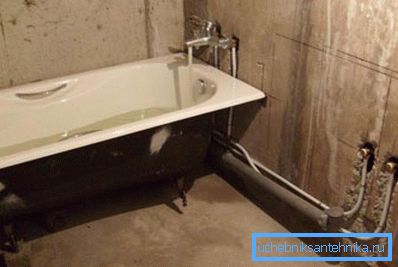
Create box
In this case, the large elements of the sewer and plumbing systems are closed with a special design consisting of metal profiles. Moisture-resistant drywall is usually used as a plating, which, after installation, can be applied to almost any finish.
Necessary materials
- Mon guide profiles with the size of 2728 mm.
- Ceiling analogues of software 6027 mm.
- Sealing tape.
- Dowels for attachment to the surface.
- Sheets of moisture resistant plasterboard thickness of 12.5 mm.
- Screws for metal.
- Reinforcement tape for joints.
- Putty for putty joints.
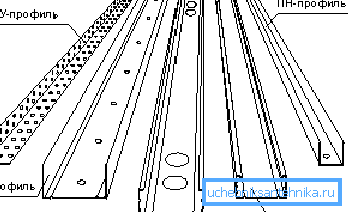
Assembly process
When it comes to how to hide the sewer pipes in the bathroom, first of all they resort to creating a box, since in most cases it is necessary to close large-sized elements. Most often the design is going to close the riser, located next to the wall.
Instructions for its manufacture are set forth below:
- At the initial stage, the marking is performed, on which metal profiles will be installed.. To this end, an equal distance on each side recedes from the pipe. Vertical lines are drawn along the side plane, the floor and the ceiling.
- The guide profiles are cut to size, after which they are fixed using dowels. Places adjoining without fail are glued by sealing tape. The face trim must rest against the front profile.
- Jumpers are installed between the outer elements in increments of 50-60 cm to make the design more rigid.. To improve sound insulation, mineral wool is placed inside. After that, the drainage of water is almost silent.
- At the last stage, the gypsum plasterboard sheets are fixed; their subsequent finishing is putty.. The connection of the coating fragments is made only on the profiles. All joints are glued with a reinforcing tape, and then plastered with putty.
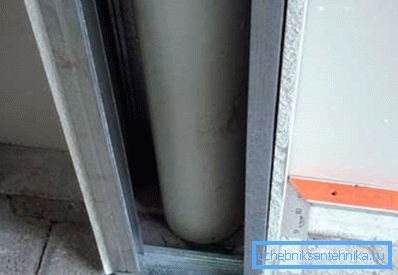
Recommendation! Beginners who do not know how to properly hide pipes in a large bathroom can be advised exactly this option. Such a design is going in just 2-3 hours.
Wall embedding
In many cases, the elements of communication networks are introduced directly into the side plane, but only components that are small in size can be hidden. If, for example, there are reflections on how to hide the faucet pipes in a bathroom, then this method should be considered first.
With the help of the grinder, sections are cut corresponding to the dimensions of the elements of the communication system. With the use of a chisel and a hammer, the shear is made to form an even channel for the gasket. Directly in it the pipe is located and filled up with cement and sand mix.
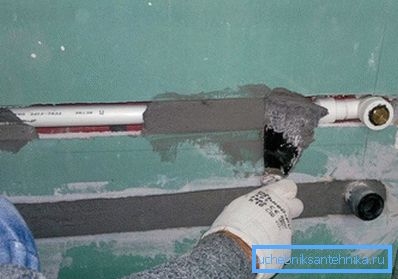
Location under the finish
If you want to hide the drainage lines or elements of the drainage system, you can create an additional layer of decoration, which will be located at some distance from the wall.
Between the facing and the side plane and there will be communication components. Next, we analyze how to hide the pipes in the bathroom with plastic panels, the price of which is low.
Materials used
- 4050 mm bars for lighthouses.
- Directly themselves plastic panels.
- Dowels and screws for mounting transverse strips.
- Staples.
- Waterproofing material.
Work
Even a novice master will be able to carry out the whole front of the work with his own hands if he becomes familiar with the order of actions. Unlike previous methods, the presented option is considered the most simple and effective.
The main elements are located in the space between the lighthouses.
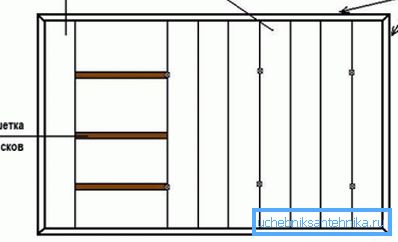
- First, wall markings are performed, for which vertical lines are drawn, along which wooden planks will be installed. The step between the stripes should be 40-60 cm.
- Along the lines are lighthouses from bars of 4050 mm. The long side is pressed against the side surface. Fastening is carried out using dowels.
- On the fixed bars, a waterproofing material is spread to improve waterproofing. With this layer, the likelihood of ingress of moisture inside almost completely disappears.
- Perpendicular to the installed beacons are mounted plastic panels. Fixation is carried out using staples and staples. When installing the elements of the crest of one strap is in the groove of the other. The last panel is cut off along the entire length, after which it is fixed.

Note! Above, information was given on how to hide the water pipes in the bathroom under the trim using beacons with a cross section of 40 x50 mm. Elements with a diameter of more than 4 cm hide under this scheme will not work.
In conclusion
After studying the presented methods, virtually every novice master will be able to understand how to hide the pipes in the bathroom, creating an aesthetically appealing interior. The method of hiding communications fragments should be chosen depending on the specific situation.
As a visual aid video is presented in this article, which also reflects additional information on this topic.